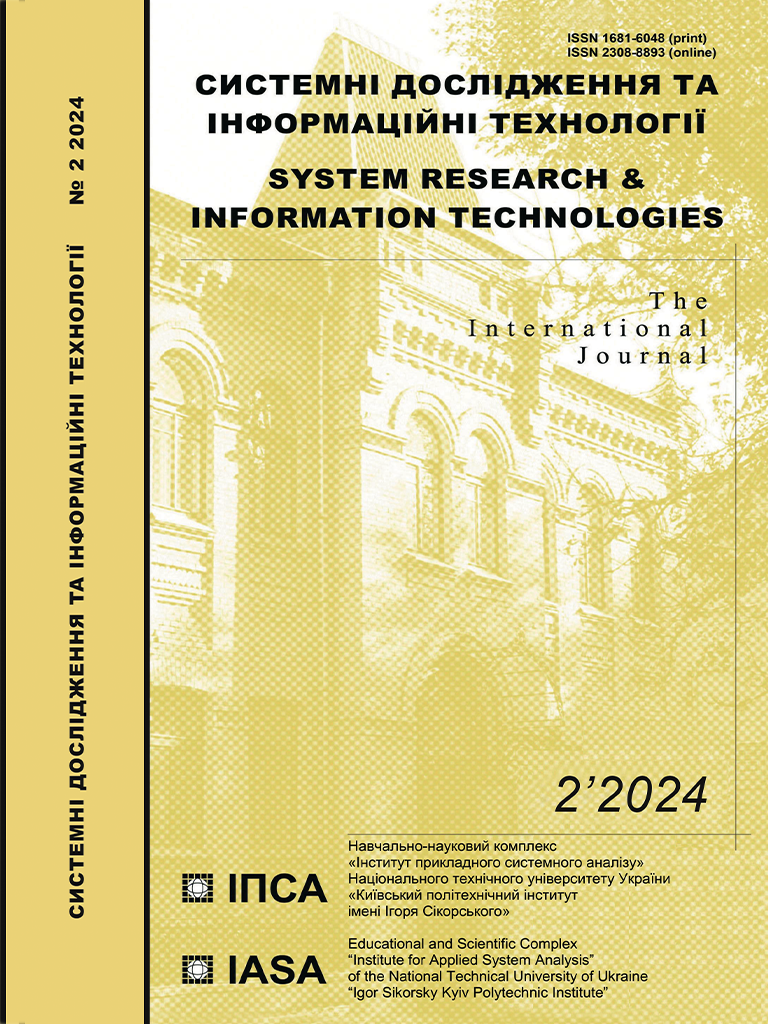Interactive decision support system for lung cancer segmentation
DOI:
https://doi.org/10.20535/SRIT.2308-8893.2024.2.05Keywords:
clinical decision support systems, deep learning, open system, interactive segmentationAbstract
This paper studies Clinical Intelligent Decision Support Systems (CIDSSs) for lung cancer segmentation, which are based on deep neural nets. A new interactive CIDSS is proposed and compared with previous approaches. Additionally, the purpose uncertainty problem in building interactive systems is discussed, and criteria for measuring both quality and amount of user feedback are proposed. In order to automate system evaluation, a new algorithm was used to simulate expert feedback. The proposed interactive CIDSS outperforms previous approaches (both interactive and noninteractive) on the task of lung lesion segmentation. This approach looks promising both in terms of quality and expert user experience. At the same time, this paper discusses a bunch of possible modifications that can be done to improve both evaluation criteria and proposed CIDSS in future works.
References
R.T. Sutton, D. Pincock, D.C. Baumgart, D.C. Sadowski, R.N. Fedorak, and K.I. Kroeker, “An overview of clinical decision support systems: benefits, risks, and strategies for success,” NPJ Digit. Med., pp. 3–17, 2020 Feb 6. doi: 10.1038/s41746-020-0221-y.
E. Walling, C. Vaneeckhaute, “Developing successful environmental decision support systems: Challenges and best practices,” Journal of Environmental Management, 264, 110513, 2020. doi: 10.1016/j.jenvman.2020.110513.
M. Rashidi, M. Ghodrat, B. Samali, and M. Mohammadi, “Decision Support Systems,” Management of Information Systems, 2018. doi: 10.5772/intechopen.79390.
N. Shahid, T. Rappon, and W. Berta, “Applications of artificial neural networks in health care organizational decision-making: A scoping review,” PLOS ONE, 14(2), e0212356, 2019. doi: 10.1371/journal.pone.0212356.
S. Mahadevan, P. Voigtlaender, and B. Leibe, “Iteratively Trained Interactive Segmentation,” ArXiv, 2018. Available: /abs/1805.04398
M.Z. Zghurovskyi, N.D. Pankratova, Systems Analysis: Problems, Methodology, Applications. K.: Naukova dumka, 2005.
S. Walsh et al., “Decision Support Systems in Oncology,” JCO Clinical Cancer Informatics, vol. 3, pp. 1–9, 2019. doi: 10.1200/CCI.18.00001.
G. Yu, Z. Chen, J. Wu, and Y. Tan, “Medical decision support system for cancer treatment in precision medicine in developing countries,” Expert Systems with Applications, 186, 115725, 2021. doi: 10.1016/j.eswa.2021.115725.
T. Mukherjee, O. Pournik, S.N. Lim Choi Keung, and T.N. Arvanitis, “Clinical Decision Support Systems for Brain Tumour Diagnosis and Prognosis: A Systematic Review,” Cancers 2023, 15(13), 3523. doi: 10.3390/cancers15133523.
B.V. Chapaliuk, Y.P. Zaychenko, “Medical image segmentation methods overview,” System Research and Information Technologies, no. 1, pp. 72–81, 2018. doi: 10.20535/SRIT.2308-8893.2018.1.05.
O. Ronneberger, P. Fischer, and T. Brox, “U-Net: Convolutional Networks for Biomedical Image Segmentation,” ArXiv, 2015. Available: /abs/1505.04597
T. Lin, P. Dollár, R. Girshick, K. He, B. Hariharan, and S. Belongie, “Feature Pyramid Networks for Object Detection,” ArXiv, 2016. Available: /abs/1612.03144
L. Chen, G. Papandreou, I. Kokkinos, K. Murphy, and A.L. Yuille, “DeepLab: Semantic Image Segmentation with Deep Convolutional Nets, Atrous Convolution, and Fully Connected CRFs,” ArXiv, 2016. Available: /abs/1606.00915
Z. Zhou, M.M. Siddiquee, N. Tajbakhsh, and J. Liang, “UNet++: A Nested U-Net Architecture for Medical Image Segmentation,” ArXiv, 2018. Available: /abs/1807.10165
H. Huang et al., “UNet 3+: A Full-Scale Connected UNet for Medical Image Segmentation,” ArXiv, 2020. Available: /abs/2004.08790
A. Hatamizadeh et al., “UNETR: Transformers for 3D Medical Image Segmentation,” ArXiv, 2021. Available: /abs/2103.10504
Y. Zaychenko, G. Hamidov, and B. Chapaliuk, The Application of CNN and Hybrid Networks in Medical Images Processing and Cancer Classification. Cambridge Scholars Publishing, 2023.
A. Kirillov et al., “Segment Anything,” ArXiv, 2023. Available: /abs/2304.02643
T. Sakinis et al., “Interactive segmentation of medical images through fully convolutional neural networks,” ArXiv, 2019. Available: /abs/1903.08205
M. Carbonneau, V. Cheplygina, E. Granger, and G. Gagnon, “Multiple Instance Learning: A Survey of Problem Characteristics and Applications,” Pattern Recognition, 2016. doi: 10.1016/j.patcog.2017.10.009.
M. Tan, Q.V. Le, “EfficientNet: Rethinking Model Scaling for Convolutional Neural Networks,” ArXiv, 2019. Available: /abs/1905.11946
L. Chen, Y. Zhu, G. Papandreou, F. Schroff, and H. Adam, “Encoder-Decoder with Atrous Separable Convolution for Semantic Image Segmentation,” ArXiv, 2018. Available: /abs/1802.02611
D.P. Kingma, J. Ba, “Adam: A Method for Stochastic Optimization,” ArXiv, 2014. Available: /abs/1412.6980
S. Li et al., “PyTorch Distributed: Experiences on Accelerating Data Parallel Training,” ArXiv, 2020. Available: /abs/2006.15704
J. Bertels et al., “Optimizing the Dice Score and Jaccard Index for Medical Image Segmentation: Theory & Practice,” Medical Image Computing and Computer Assisted Intervention – MICCAI 2019. doi: https://doi.org/10.1007/978-3-030-32245-8_11
Q. Xie, M. Luong, E. Hovy, and Q.V. Le, “Self-training with Noisy Student improves ImageNet classification,” ArXiv, 2019. Available: /abs/1911.04252
M. Kimura, “Understanding Test-Time Augmentation,” in Neural Information Processing. ICONIP 2021. Lecture Notes in Computer Science, vol. 13108. Springer, Cham, 2021. doi: https://doi.org/10.1007/978-3-030-92185-9_46
S.G. Armato III et al., “Data From LIDC-IDRI [Data set],” The Cancer Imaging Archive, 2015. doi: http://10.0.31.1/K9/TCIA.2015.LO9QL9SX
Matthew C. Hancock, Jerry F. Magnan, “Lung nodule malignancy classification using only radiologist quantified image features as inputs to statistical learning algorithms: probing the Lung Image Database Consortium dataset with two statistical learning methods,” Journal of Medical Imaging, 3(4), 044504, 8 December 2016. doi: https://doi.org/10.1117/1.JMI.3.4.044504
H. Rezatofighi, N. Tsoi, J. Gwak, A. Sadeghian, I. Reid, and S. Savarese, “Generalized Intersection over Union: A Metric and A Loss for Bounding Box Regression,” ArXiv, 2019. Available: /abs/1902.09630
Z. Wu, C. Shen, and A. van den Hengel, “Bridging category-level and instance-level semantic image segmentation,” arXiv preprint, 2016. Available: https://doi.org/10.48550/arXiv.1605.06885

